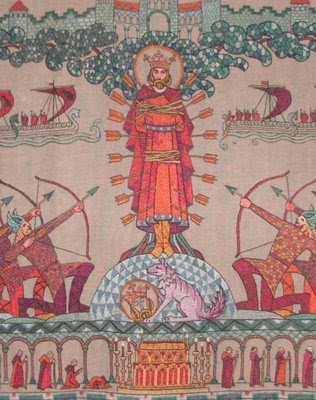St. Edmund King, Martyr
Description
St. Edmund King, Martyr

It is commonly known that St. George is the Patron Saint of England. We celebrate St George’s Day on April 23rd when the red cross of St George flies proudly from the flag pole. But should we instead be raising the White Dragon flag on November 20th? It is surprising to learn that St George was not the first patron saint of England. That honour was originally held by St Edmund, or Edmund the Martyr, King of East Anglia in the 9th century. Here are 10 + 1 quick facts and curiosities about St. Edmund:
1. Edmund was crowned King of East Anglia at Bures in Essex on Christmas Day 855.
2. He died on 20 November 869, now marked as St Edmund’s Day. He refused to give up his Christian faith and so was tied to a tree and shot full of arrows before being beheaded. According to a legend his decapitated head is said to have been reunited with its body with the help of a talking wolf who protected the head and then called out “Hic, Hic, Hic” (“Here, Here, Here”) to alert Edmund’s followers.
3. Edmund is the patron of Kings, pandemics, the Roman Catholic diocese of East Anglia, Douai Abbey, wolves, torture victims, and protection from the plague.
4. It is still a mystery where Edmund was killed. In 1101 Haegelisdun (or Hellesden) is mentioned as being the spot where Edmund was martyred. For many years Hoxne claimed this honour. Another theory is that it is Bradfield St Clare, south of Bury St Edmunds.
5. One miracle attributed to Saint Edmund tells the story of a blind man with a boy who sheltered overnight in the chapel who left in the morning with his eyesight restored.
6. By 1014, the formidable Danish warrior Sweyn Forkbeard, had seized most of England and proclaimed himself King. According to legend, the people’s prayers to St. Edmund were answered when Sweyn cried out in agony early one morning ‘I am struck by St Edmund’ and died.
7. St Edmund’s shrine at the Abbey of St Edmund in Bury St Edmunds became one of the most famous and wealthy pilgrimage locations in England. For centuries the shrine was visited by various kings of England, many of whom gave generously to the abbey.
8. The Abbey of St Edmund was destroyed during the dissolution of the monasteries in 1539. Edmund’s bejewelled shrine was plundered but his remains were removed to France where they remained until 1911. Today they are kept in the chapel in Arundel Castle.
9. St. Edmund’s influence began to fade when, during the Third Crusade in 1199, King Richard I visited the tomb of St. George in Lydda on the eve of battle. The next day he won a great victory. Following this triumph, Richard adopted St. George as his personal patron and protector of the army. Although the banner of St. Edmund was still carried into battle by the English army, by the time of Edward I it had been joined by the flag of St. George. In 1348, Edward III founded a new order of chivalry, the Knights of the Garter. Edward made St. George the patron of the Order and also declared him Patron Saint of England.
10. An attempt was made in 2006 to have St. Edmund reinstated as patron saint of England. A petition was handed into Parliament but it was rejected by the government. In 2013 another campaign was launched to reinstate St. Edmund as patron saint. This was the ‘St. Edmund for England’ e-petition, backed by the Bury St Edmunds based brewery, Greene King. This tongue-in-cheek yet serious campaign questioned whether St. George, patron saint of 16 other countries, ever even visited England. It suggested he should be replaced by an Englishman, and who better than the Anglo-Saxon martyr-king, St. Edmund.
+1. Between 1233 and 1258, Franciscan friars attempted to establish themselves in the town of Bury St Edmunds, which was jealously guarded by the Benedictine monks of St. Edmunds abbey. In the ensuing conflict (which sometimes spilled over into acts of violence), the monks invoked St. Edmund as the protector of the abbey. The monks eventually managed to eject the friars from the town in 1263. By calling on the saints, both sides elevated the clash between new and old religious orders to the heavenly plane, but the popularity of the new saint, Francis, complicated the monks’ efforts…
(++1… As it was more difficult and more expensive to find a statue of St. Edmund King than to purchase a statue of a much more popular Saint, in a Norfolk church there is a St. Sebastian statue venerated as St. Edmund. They simply removed St. Sebastian’s name from it and put a crown on his head. As St. Sebastian was also tied to a tree and shot full of arrows, the “trick” was not noticed by anyone…)

